Timeline (Static View)

April 30, 1789
George Washington was inaugurated as the first President of the United States on the balcony of the First Federal Hall in New York which served as the seat of the federal government until 1790, when the capital was moved to Philadelphia. It was in this building that President Washington signed the Fifth Act of Congress, creating the Customs Service.
After the federal government moved to Philadelphia in 1790, Federal Hall became the Customhouse for the Customs Collection District of New York.
First Federal Hall at Wall and Nassau Streets, Lower Manhattan, New York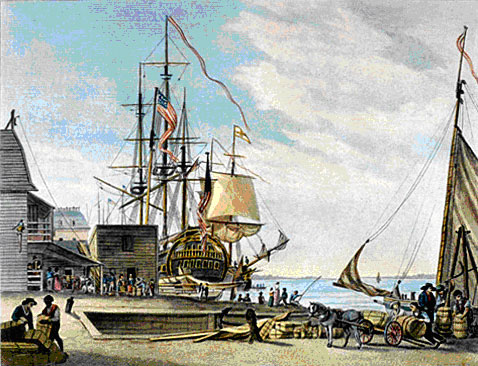
July 20, 1789
3rd Act of the First Congress of the United States establishes a system of tariffs on the tonnage of ships.
"Arch Street Landing" in Philadelphia. Engraving by W. Birch, dated 1800. In the early years of the nation, the port of Philadelphia was the largest in the nation.July 4, 1789
2nd Act of the First Congress of the United States establishes a systems of tariffs on imported "goods and merchandises" in order to fund the new federal government.
July 31, 1789
5th Act of the First Congress of the United States establishes 59 customs collection districts in the 11 states that had ratified the new Constitution. Ports of entry, under the jurisdiction of a Collector of Customs, are designated by the Act, and the organization would soon come to be known as the U.S. CUSTOMS SERVICE.

August 7, 1789
9th Act of the First Congress establishes the LIGHTHOUSE SERVICE. This is the first non-revenue responsibility assigned to Collectors of Customs, which was tasked with the design, construction, staffing and management of lighthouses in their Customs districts.
Cedar Point Lighthouse Nantucket Mass., built in 1818.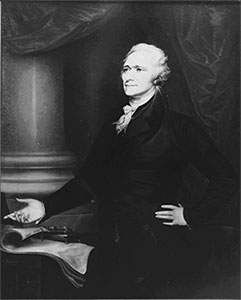
September 2, 1789
11th Act of the First Congress of the United States establishes the DEPARTMENT OF THE TREASURY; Secretary of the Treasury is responsible for the management of all matters pertaining to the collection and protection of U.S. revenue.
Alexander Hamilton: first Secretary of the Treasury served 1789 - 1797.
1790
Congress authorizes Treasury Secretary to undertake the building of 10 CUSTOMS REVENUE CUTTERS. Customs Collectors were tasked with the design, building and selection of crews and captains, and management of the U.S. REVENUE MARINE.
October 4, 1813; flying the U.S. Customs ensign and pennant, the Customs Revenue Cutter "Valiant" fires on British privateer "Dart" off Block Island, Rhode Island.1791
Congress authorizes the President to utilize the U.S. Revenue Marine for the defense of the nation. (The U.S. Navy was not established until 1798.)
SPECIAL TREASURY AGENT position is created. From 1846-1860, agents submitted reports to the Treasury Department through the Collectors of Customs in the Customs district where they were employed. After 1860, the agents reported directly to the Department of the Treasury.
November 19, 1794
American statesman and U.S. Supreme Court Chief Justice John Jay signs the Amity, Commerce, and Navigation Treaty with Great Britain. Known as JAY’S TREATY, it provides for British evacuation of its Northwestern posts by June 1796, and allows settlers to decide if they become Americans or remain British citizens.
January 29, 1795
The NATURALIZATION ACT of 1795 changes residency requirements from two to three years and introduces the Declaration of Intention.
May 27, 1796
QUARANTINE AND HEALTH ACT enables the President to use Customs Collectors to enforce quarantine and state health laws.

1798
Establishment of the MARINE HOSPITAL SERVICE. Customs Collectors are charged with collecting hospital duties and with the construction/acquisition of marine hospitals. In 1809, the Collectors are authorized to fix all rules for the governing of the marine hospitals.
Left: U.S. Marine Hospital at Chelsea, Mass. completed in 1830. Right: U.S. Marine Hospital at Key West, Fla.June 25, 1798
The NATURALIZATION ACT OF 1798 (part of the Alien and Sedition Acts) permits the deportation of foreigners deemed to be dangerous and increases the residency requirements to 14 years.

1799
Treasury Secretary Oliver Wolcott designs the CUSTOM ENSIGN and PENNANT, and Congress declares these are to be flown on all Customs revenue cutters to indicate the authority of the United States government. This is the first flag designed specifically for an agency of the federal government.
From manuscript: "Early American Maritime Flags & Signals" © 1999 Ray S. MortonU.S. Customs Ensign & Pennant - Type of 1799. The 15 stars represent the number of states in the Union in 1799.1802
The NATURALIZATION ACT OF 1798 is revised to reduce the residency requirement from 14 to 5 years.
April 30, 1803
The treaty finalizing the LOUISIANA PURCHASE is signed in Paris, changing the borders of the United States.
1808
Importation of slaves in the United States is officially banned, though it continues illegally.
1819
The STEERAGE ACT requires shipmasters to deliver lists of all aliens seeking immigration to the local Collector of Customs.

J. Rosse Browne 1821-1875
An artist/writer/lecturer Ross Browne also shares the distinction of being one of the earliest SPECIAL AGENTS of the TREASURY.
Ross Browne's earliest federal appointment was in 1849, when Treasury Secretary R.J. Walker assigned him to investigate financial irregularities in the offices of the Customs Collectors at ports along the west coast. He was also tasked with investigating problems with the captain and crew of the revenue cutter of Conelius W. Lawrence in Astoria, Oregon. Being advised that he should avoid the delay and expense of crossing overland to the Pacific through Panama. It took Browne 6 1/2 months to sail from New York to San Francisco via Cape Horne, including Treasury business stops in Lima, Peru and Rio de Janerio.
In August 1853, Browne was appointed as Special Agent of the Treasury by Secretary James Guthrie. For the next two years, Ross Browne's assignments, to investigate the financial operations of the Collectors' offices, took him to ports of entry throughout the U.S.
Self Portrait - J. Ross Browne1836
The COMMISSIONER OF PATENTS begins to distribute seeds and plants of foreign origin to farmers throughout the country.

December 22, 1837
The LIFE SAVING SERVICE is established in the Department of Treasury; in the 1840's this vital rescue service is placed under the direction of the U.S. Revenue Marine, which at that time is under the management of the Collectors of Customs at the ports of entry.
Historic American Buildings Survey (HABS) measured drawingEarliest Life Saving Station at Sandy Hook, NJ - built in 1848.1840s
Crops failures in Germany, social and political unrest in Europe, and the Irish Potato Famine (1845-1851) lead to mass immigration to the United States.
1848
The TREATY of GUADALUPE HIDALGO ends the Mexican-American War and extends citizenship to approximately 80,000 people in Texas, California, and the American Southwest. The treaty also extends the US boundary by over 25,000 square miles and establishes the Rio Grande as the international border.
Congress passes the DRUG IMPORTATION ACT of 1848 to address the purity of drugs imported into the United States. The Act calls for the appointment of special examiners at six ports of entry - New York, Boston, Philadelphia, Baltimore, Charleston and New Orleans.
1849
California gold rush spurs immigration from China and extensive internal migration.

1789-1853
As a matter of expediency, privately held buildings such as banks and commercial buildings are purchased by the federal government for the express purpose of accommodating the needs of the Customs Service - an example being the the beautiful U.S Custom House in Philadelphia, Pennsylvania.
U.S. Custom House, Philadelphia, Pa.1853-1939
The position of the SUPERVISING ARCHITECT of the TREASURY oversees the design and construction of federal buildings until the creation of the PUBLIC BUILDINGS ADMINISTRATION in 1939.

1853
U.S. CUSTOMS BORDER PATROL is established when the Treasury Secretary authorized the Collectors of Customs to hire CUSTOMS MOUNTED INSPECTORS for patrol duty along U.S. land borders.
Earliest known U.S. Customs badge worn by Customs Inspectors Customs Mounted Inspectors circa 1874.August 3, 1855
Castle Garden, previously a War of 1812 fort named Castle Clinton, opens as an immigrant landing depot. During the next 34 years, over 8 million people enter the United States through Castle Garden. It closes on April 18, 1890.

Jefferson Davis Milton a.k.a Jeff Milton 1861-1947
Jeff Milton, youngest son of a Florida governor, spent most of his long life in a succession of law enforcement jobs. Arriving in Texas at 16, he starts out as a cowhand. Claiming to be 20, he qualifies to join the Texas Rangers in 1878, and serves for four years.
Milton joins the U.S. Customs Service in 1887 and is appointed a CUSTOMS MOUNTED INSPECTOR headquartered in Tucson, in the Customs Collection District of El Paso. Milton spends two years with Customs, riding the line from Nogales westward to the Colorado River. As a political appointee, Milton finds himself out of a job in 1889, when a new political party takes over the reins of federal power.
After spending fifteen years as a "spotter" with the Southern Pacific railroad, and being involved in a shootout with train robbers that left him with a permanently disabled arm. Milton joins the Bureau of Immigration in 1904 as a MOUNTED CHINESE INSPECTOR charged with enforcement of the Chinese Exclusion Act.
At 62, Jeff Milton becomes the first officer appointed to the U.S. Immigration Service Border Patrol in 1924, and for the next 8 years he pursues border patrol work with unbridled enthusiasm.
The Economy Act of 1932 forces the still active Milton into retirement at age 70. The Sector Chief at El Paso writes in praise of him: You have come to be regarded "as an institution rather than an individual. No other immigration officer has your value in cultivating for the Service the good will and friendship we must have for effective enforcement of the law."
Circa 1888: Col. Abner Tibbetts (center) poses with 5 of the 25 Customs Mounted Inspectors assigned to the Customs Collection District of El Paso. Seated on the right is CUSTOMS MOUNTED INSPECTOR Jeff Milton.1861
Congress passes the MORRILL ACT providing for increases of import tariffs. The revenue funds in part Union costs for the American Civil War.
1862
The BUREAU OF INTERNAL REVENUE and a personal income tax are established by the Treasury Department in order to fund the costs of the Civil War. When the war ended, the Bureau and the income tax are abolished. Throughout this period, the Customs Service continues to be the major source of funding for the U.S. Treasury.
The U.S. Department of Agriculture establishes consular offices in foreign countries to obtain seeds and plants.
May 25, 1862
President Lincoln establishes the U.S. DEPARTMENT OF AGRICULTURE (USDA) without cabinet level status, and headed by a Commissioner of Agriculture. The USDA is charged to "procure, propagate and distribute among the American people new and valuable seeds and plants."
1863
The Central Pacific hires Chinese laborers and the Union Pacific hires Irish laborers to construct the first transcontinental railroad.
1870
SPECIAL AGENCY SERVICE established as a branch office in the Office of the Secretary of the Treasury. Three classes of Special Agents were established, according to the compensation each class was to receive.
The NATURALIZATION ACT 1870 expands citizenship to whites and African-Americans, while still excluding Asians and American Indians.
1871
The REVENUE MARINE DIVISION combines the four Treasury functions of U.S. Revenue Marine, Life Saving, Steamboat Inspection and Marine Hospitals.
In 1894, the Revenue Marine Division is renamed the REVENUE CUTTER SERVICE, and on January 28, 1915, becomes the U.S. COAST GUARD.
1875
The Supreme Court rules that immigration regulation is a federal responsibility.
The PAGE ACT of 1875 prohibits the entry of immigrants considered undesirable.
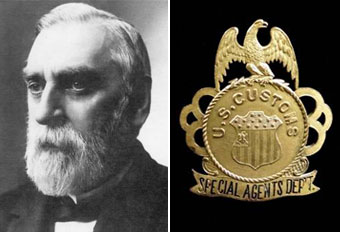
1879
Congress enables the creation of the of the position "Fraud Roll Employee" in the Treasury Department's DIVISION OF SPECIAL AGENTS. Employees of the fraud roll were to detect and prevent fraud of the customs revenue; their credentials classify them as SPECIAL EMPLOYEES OF THE TREASURY. Early documentation and emblems show they were often titled CUSTOMS AGENTS and SPECIAL AGENTS.
Left: Oliver L. Spalding Special Agent - Detroit in 1885 Customs Agent - Baltimore in 1915; Right: Earliest known styling for Customs agent badge - circa 1888.July 2, 1881
President Garfield is shot by Charles Guiteau, a disgruntled office seeker. This incident led to the passage of the Pendleton Act in 1883 and creation of the Civil Service, thus changing how government workers secure their positions.

1882
The IMMIGRATION ACT OF 1882 levies a 50-cent tax on each non-citizen arriving at a U.S. port of entry to defray costs of implementing immigration laws.
The CHINESE EXCLUSION ACT cuts off legal immigration from China and outlaws granting of citizenship to the Chinese. This law places tremendous pressures on the Collectors of Customs and Customs Agents, who were charged with enforcing this law as fairly and equitably as possible.
Harper's Weekly 1877Chinese immigrants patiently await U.S. Customs inspections on arrival at the Barge Office for the Port of San Francisco, California.1883
Animal quarantine stations under the jurisdiction of the Customs Collectors and the Treasury Department in Baltimore, Boston, New York City and Philadelphia, are transferred to the BUREAU OF ANIMAL INDUSTRY within the newly established Department of Agriculture.
1885
The ALIEN CONTRACT LABOR LAW prohibits businesses from bringing people into the country for work except those who perform domestic service or skilled workmen needed to help establish a new trade or industry.
1886
The STATUE OF LIBERTY is dedicated in New York Harbor.
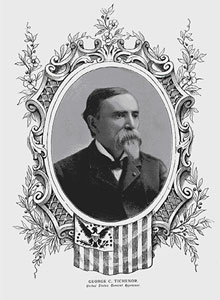
1890
The Customs Administrative Act establishes the BOARD OF GENERAL APPRAISERS, with the power and authority previously exercised and possessed by the Treasury Secretary in customs disputes. In 1926, the Board of General Appraisers was renamed the UNITED STATES CUSTOMS COURT.
George C. Tichenor, U.S. General Appraiser 1890.1891
Congress passes the IMMIGRATION ACT of 1891 denying entry to "persons suffering from a loathsome or a dangerous contagious disease," those convicted of a "misdemeanor involving moral turpitude," and polygamists.
March 3, 1891
Act of Congress establishes federal control over immigration and creates new executive position under the Treasury Secretary: SUPERINTENDENT of IMMIGRATION, who is now responsible for implementing national immigration policy, and charged with enforcing national laws and regulations regarding the processing, admittance or rejection of all persons seeking admission to the U.S.

Immigration processing and quarantine at the port of New York 1855-1924
From 1855-1891 CASTLE GARDEN (formerly Fort Clinton), at the tip of Manhattan, serves as the immigration station for the port of New York. In 1860, a full-fledged immigrant hospital is opened on HOFFMAN ISLAND, and a quarantine station for infectious diseases is opened on SWINBURNE ISLAND. Both islands are man made and located near Ellis Island in New York Harbor, and were abandoned in 1900 when the new Ellis Island immigration station opened.
Edwick Levin photo; NY Public Library Digital CollectionMain administration Building on Ellis Island - Immigrants were transferred from their incoming ships docked at the tip of Manhattan to federal barges which carried them to this building, where their immigration and health processing would begin and end.January 1, 1892
The ELLIS ISLAND IMMIGRATION STATION in New York habor is opened. The wood building burns to the ground in 1897, and all immigrant processing is moved to the U.S. Customs Barge Office adjacent to Battery Park in lower Manhattan.
1892
The GEARY ACT extends the Chinese Exclusion Act for ten years and requires all Chinese residents to carry permits. The act excludes them from serving as witnesses in court and from bail in habeus corpus proceedings.
1895
Act of Congress creates the BUREAU OF IMMIGRATION in the Treasury Department. The same Act provides for the Presidential appointment of COMMISSIONERS GENERAL OF IMMIGRATION to serve at several points of entry, whose terms of appointment are to be four years.
1900
Congress passes the LACEY ACT which restricts the importation of "injurious species."

December 16,1900
Opening of the rebuilt NEW YORK IMMIGRATION STATION on ELLIS ISLAND.
The BUREAU OF IMMIGRATION and the PUBLIC HEALTH AND MARINE HOSPITAL SERVICE (later the PUBLIC HEALTH SERVICE) work in partnership to process more than 12 million immigrants on Ellis Island between 1900 and November 12, 1954, when the immigration station was closed.
September 6, 1901
President William McKinley is shot by a Polish anarchist causing Congress to pass the ANARCHIST EXCLUSION ACT, prohibiting entry to people judged to be anarchists or political extremists.
1902
Establishment of the PUBLIC HEALTH AND MARINE HOSPITAL SERVICE in the Treasury Department. In 1912, the agency is renamed the PUBLIC HEALTH SERVICE.
The Chinese Exclusion Act is renewed with no ending date.
1903
The BUREAU OF IMMIGRATION is moved to the newly created Department of Commerce and Labor.
1906
The BUREAU OF IMMIGRATION AND NATURALIZATION (INS) is created to administer the first uniform naturalization laws in the United States.
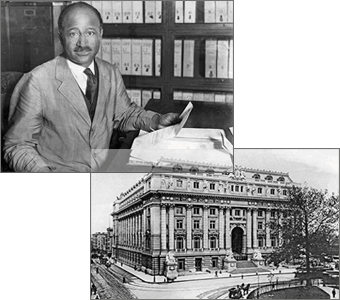
June 29, 1906
The BASIC NATURALIZATION ACT OF 1906 provides a uniform rule for the naturalization of aliens throughout the United States and the courts are required to use standard naturalization forms. This Act required that all applicants for naturalization be able to speak English.
The Department of Commerce and Labor is split into two separate departments. The Bureau of Immigration and the Bureau of Naturalization are joined into a single entity titled the BUREAU OF IMMIGRATION AND NATURALIZATION in the Department of Labor.
Matthew Henson (left) accompanied Admiral Robert Peary on seven Arctic and Polar expeditions, reaching the North Pole in 1909. In 1913, he was appointed to an administrative position in the Collector’s office in the New York Custom House at Bowling Green.1907
The DILLINGHAM COMMISSION is formed to investigate immigration issues.
The EXPATRIATION ACT declares that an American woman who marries a foreign national loses her citizenship.
1909
Congress establishes the U.S. COURT OF CUSTOMS APPEALS, an appellate court with nationwide jurisdiction, that is today's COURT OF APPEALS for the FEDERAL CIRCUIT.

January 28, 1910
President Taft approves the burning of diseased cherry trees given by Japan to beautify Washington, D.C. Agriculture Secretary James Wilson uses the incident to highlight the risks of agricultural imports, and, thus, secures the Plant Quarantine Act of 1912. Japan replaces the diseased trees, and the new trees are planted along the Potomac River.
Photo courtesy of the National Arboretum1911
The DILLINGHAM COMMISSION, established in 1907, publishes a 42-volume report warning that the "new" immigration from Southern and Eastern Europe threatens American society. The Commission's recommendations provide the foundation for the Quota Acts of the 1920s.
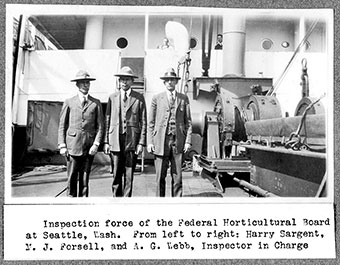
1912
The PLANT QUARANTINE ACT establishes the FEDERAL HORTICULTURAL BOARD (FHB) in the Department of Agriculture and authorizes plant quarantines. Uniformed FHB Inspectors are co-located at the major ports of entry with Customs, Immigration, and Public Health Service Inspectors. The FHB becomes part of the Animal and Plant Health Inspection Service (APHIS) in 1972.
1913
The Department of Labor creates two new bureaus: the BUREAU OF IMMIGRATION and the BUREAU OF NATURALIZATION.
1915
Congress authorizes the Bureau of Immigration to deploy MOUNTED GUARDS along the southwest border.
Immigration Controls 1917-1924
The passage of the IMMIGRATION ACT of February 15, 1917, adds qualifications for admission and increases the head tax to $8 per immigrant.
1917
Congress enacts a literacy requirement for immigrants by overriding President Woodrow Wilson's veto. The law requires immigrants to be able to read 40 words in some language and bans immigrants from Asia, except for Japan and the Phillipines.
The Jones-Shafroth Act grants U.S. citizenship to Puerto Ricans.
January 1920 - December 1933 PROHIBITION ERA
During this 13 year period, customs and immigration enforcement along U.S. borders and seacoasts was in crisis, and the toll on federal officers was great. The U.S. Customs Border Patrol lost 20 officers in the line of duty; the U.S. Immigration Service lost 4 inspectors and the U.S. Immigration Service Border Patrol lost 24 officers in the line of duty.
May 19, 1921
A temporary quota act limits the number of immigrants from individual foreign nations.

1922
U.S. Customs Service Patrol begins to utilize seized aircraft to enable aerial surveillance and enforcement. Thirty-five aircraft were seized for smuggling by Customs Patrol in 1932 alone and leads to the establishment of an unofficial Customs Patrol air group, which enthusiastically patrolled the southern border for smugglers and their aircraft.
The CABLE ACT partially repeals the Expatriation Act, but declares that American woman who marry Asian nationals still lose their citizenship.
Curtis Falcon 2576 displays a non-official Customs seal.1923
The Supreme Court rules in the case of United States v. Bhaghat Singh Thind that Indians from the Asian subcontinent cannot become U.S. citizens.
1924
The Bureau of Immigration creates the IMMIGRATION BOARD OF REVIEW to examine deportations appeals.
The ORIENTAL EXCLUSION ACT prohibits most immigration from Asia, including foreign-born wives and children of American citizens of Chinese ancestry.
May 26, 1924
The Quota Act limits immigration into the United States to 150,000 annually and institutes the "national origins" provision that allocates quotas for foreign nations based on existing representation in the U.S. population.

May 28, 1924
The Appropriations Act creates the U.S. IMMIGRATION SERVICE BORDER PATROL in the DEPARTMENT OF LABOR.
August 21, 1927 - U.S. Immigration Service Border Patrol in front of the El Paso Sector Office.May 1, 1927
Jurisdiction of the SPECIAL AGENCY SERVICE is transferred by the Treasury Department to the newly established BUREAU OF CUSTOMS, and renamed the CUSTOMS AGENCY SERVICE.
April 16, 1927
Treasury Decision 42102 creates an independent BUREAU OF CUSTOMS, in the Department of the Treasury. Ernest Camp is selected to be the first COMMISSIONER OF CUSTOMS.
1927-1929
A BUREAU OF PROHIBITION is created, but is abolished in two years because of overlapping responsibilities with Customs and Immigrations patrols.
1928
The PLANT QUARANTINE AND CONTROL ADMINISTRATION in the Department of Agriculture brings exclusion (safeguarding) and plant health programs under one federal umbrella.
1929
The National Origins Formula caps annual immigration at 150,000 and completely bars Asian immigration.

1932
The Plant Quarantine and Control Administration (PQCA) is renamed the BUREAU OF PLANT QUARANTINE in the Department of Agriculture.
Agriculture inspectors at the U.S. border Inspection Station at El Paso, Texas in the 1930s
May 1933
The title of Customs Mounted Inspector is changed to CUSTOMS PATROL INSPECTOR reflecting the transition to automobiles.
Company "E" - U.S. Customs Border Patrol - Detroit, MichiganJune 10, 1933
The Bureau of Immigration and the Bureau of Naturalization, in the Department of Commerce and Labor, are merged and transferred into the newly created Department of Labor as the U.S. IMMIGRATION AND NATURALIZATION SERVICE (INS).
1934
All activities involving aircraft are consolidated under control of the Coast Guard (at the time under the Treasury Department). Customs continues to supervise all Treasury activities dealing with detection and prevention of smuggling of liquor and narcotics along the seacoasts and borders between the ports of entry. Customs aircraft are placed under direction of the Coast Guard Division Commanders for this purpose - however, certain Customs agents continue to fly confiscated aircraft without authorization.
Congress passes the Tydings-McDuffle Act that grants independence to the Philippines and strips Filipinos of American citizenship.

December 3, 1934
The INS BORDER PATROL TRAINING SCHOOL opens at Camp Chigas in El Paso; 34 trainees attend classes in marksmanship and horsemanship.
1935
Establishment of the U.S. CUSTOMS SERVICE SCHOOL OF INSTRUCTION. Classes initially take place at the Port of New York. Harry F. Worley develops the training program and is responsible for the preparation of more than 40 lesson plans on diverse subjects, including a history of Customs.
1936
Customs Border Patrol is placed under the Customs Agency Service. Four Customs Patrol districts are established, with headquarters at Buffalo, New York; Jacksonville, Florida; El Paso, Texas and Havre, Montana.
February 7, 1936
The U.S. signs the MIGRATORY BIRD TREATY with Mexico.

March 28, 1936
Customs DIVISION OF LABORATORIES is established. Nine laboratories are spread throughout the country, all under the supervision of the Chief, Division of Laboratories at Customs headquarters.
Chief Chemist Walter L. Howell in the New Orleans Customs LaboratoryJune 25, 1936
Congress repeals the Cable Act.
1940
On July 14, 1940, the U.S. Immigration and Naturalization Service (INS) is transferred from the Department of Labor into the Department of Justice, where it will remain until March 1, 2003.
Congress passes the ALIEN REGISTRATION ACT that requires that all aliens over the age of 14 are registered and fingerprinted.

World War II
The United States enters World War II in December of 1941. As in World War I, the U.S. military and the Coast Guard assume overall control of the port security, with the Customs Service, Immigration and Naturalization Service and the State Department maintaining port operations.
Non-uniformed women had been employed at lighthouses and ports of entry since the 19th Century. After the December 7, 1941, attack on Pearl Harbor large numbers of women began joining the federal inspection services at the ports of entry, as the men went into military service.
Identification cards were issued to everyone who had a need to enter the port zone and the ships docked at ports. Even local barbers brought in to cut quarantined foreign crews' hair on board ship had to have official identification cards.
Kathleen Dixson - 1943
Originally a stenographer in the office of the Collector of Customs at the Port of Miami, Florida, Kathleen Dixson is appointed the port's first Customs Inspectress in 1943. Collector A.J. Angle suggests she should get a uniform similar to that worn by the male inspectors.
Kathleen Dixson is credited with being the first to wear an official Customs uniform designed for women. This 1943 photograph shows Dixson surrounded by her peers at the Port of Miami.
1942-1964
World War II increased the demands for agricultural workers, as food production was considered vital to winning the war. For the first time since World War I, it becomes necessary to recruit alien labor. A signed agreement between the U.S. and Mexico goes into effect on August 4, 1942, and provides for the importation of Mexican agricultural workers - known as the BRACEROS PROGRAM.
1943
H-2A guest worker program begins when the Florida sugar cane industry obtained permission to hire Caribbean workers to cut sugar cane on non-immigrant temporary visas.
1945
The War Brides Act facilitates the admission of spouses and families of returning American veterans.
1948
The Displaced Persons Act of 1948 and the Refugee Act of 1953 allow admittance to the United States many refugees displaced by WWII and unable to enter the country under regular immigration procedures. These acts ultimately allow the admission of about 400,000 people.
Customs Patrol Service is abolished.
1950s
Public alarm over illegal aliens results in strengthening border controls and launching targeted deportation programs, most notably OPERATION WETBACK. Concern about criminal aliens prompts investigation and deportation of communists, subversives and organized crime figures.

1951
A flag identification project authorized by President Truman determines the eagle displayed in the union of the Customs ensign is not proper.
The union of the Customs ensign is changed to display the Great Seal of the United States, having an American Bald Eagle holding an olive branch with 13 olives in his dexter talon, and 13 arrows in his sinister talon; his beak carries a scroll inscribed with "E Pluribus Unum"; on his breast is a shield of 13 red and white pales with a chief of blue, and above the eagle's head a glory breaking through a cloud and surrounding 13 stars forming a constellation.
The official flag of U.S. Customs and Border Protection (CBP).1952
CUSTOMS CO-OPERATION COUNCIL (CCC) is charged with ensuring the highest degree of harmony and uniformity in Customs systems worldwide.
Congress passes IMMIGRATION AND NATIONALITY ACT which establishes a system of preferences for skilled workers and relatives of citizens and permanent residents. It also amplifies security and screening requirements, consistent with Cold War alliances.
1953
Plant Quarantine and Bureau of Entomology are transferred to the Agricultural Research Service.
1956
The U.S. BORDER PATROL CANINE PROGRAM begins with the purchase of surplus sentry dogs from the U.S. military.
August 10, 1961
President John F. Kennedy assigns Border Patrol agents to prevent aircraft hijacking.
October 23, 1961
Federal Aviation Administration (FAA) peace officers replace Border Patrol agents in preventing aircraft hijacking.
1965
The IMMIGRATION ACT OF 1965, also known as the HART-CELLER ACT, abolishes the national origins system as established in the Immigration Act of 1924 and modified by the Immigration Act of 1952.
1966
CUSTOMS COMPUTER CENTER goes online.
1968
U.S. CUSTOMS NATIONAL TRAINING CENTER opens at Hofstra University in Uniondale, N.Y.
1969
CUSTOMS AIR INTERDICTION PROGRAM is established within the Customs Agency Service.

1970
Prompted by hijacking U.S. flag air carriers, the Treasury and Transportation departments initiate a crash AIR SECURITY PROGRAM with U.S. Customs, designated as lead.
CUSTOMS begins its CANINE PROGRAM with ex-military sentry dogs and handlers; training takes place at Lackland Air Force Base in Texas, where preparing a dog for Customs operations takes approximately 2 months.
TREASURY ENFORCEMENT COMMUNICATIONS SYSTEM (TECS) begins operations with 20 terminals at the San Ysidro port of entry. TECS provides instantaneous information to aid in detection of violations, enforcement data to evaluate programs & performance, statistics for the allocation of resources and data for intelligence on violation patters, modus operandi & profiles.
1971- Sky Marshals training at Fort Belvoir, Virginia: At the close of the program in June 1974, most CSO's were accepted as Customs Patrol Officers, Special Agents, Inspectors, as well as various non-enforcement positions.April 4, 1972
Meat and poultry inspection functions in the Department of Agriculture are transferred to the newly established ANIMAL AND PLANT HEALTH INSPECTION SERVICE (APHIS).
April 4, 1973
The Bureau of Customs is renamed the UNITED STATES CUSTOMS SERVICE.
1974
U.S. Customs Automated Merchandise Processing System (AMPS) goes operational in Philadelphia.
1975
The Federal Law Enforcement Training Center (FLETC) moves to a new campus in Glynco, Ga.
1977
The Border Patrol Academy at Los Fresnos closes and recruits are trained at the Federal Law Enforcement Training Center.
1981
Mariel boatlift brings waves of Cubans to American shores.
September 1981
The United States signs an agreement with Haiti to interdict Haitian boats and return prospective immigrants to Haiti. Under the agreement, 3,107 Haitians are returned by 1984.
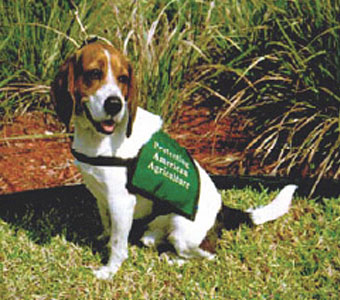
1984
The Department of Agriculture (USDA) establishes a detector dog program at Los Angeles International Airport. The Animal and Plant Health Inspection Service (APHIS) selects beagles as the breed, and the USDA's Detector Dogs become known as the BEAGLE BRIGADE.
From "The Gizmo Tales: Hero Dogs." © 2005 by Jeri Fink and Donna Paltrowitz; Book Web Publishing, Ltd. Baltimore, MD.This is TROUBLE, a 31 pound, 7 year old member of the APHIS Beagle Brigade stationed at Miami International Airport in 2005.1986
The H-2 guest worker program is divided into the H-2A agricultural program and the H-2B non-agricultural program.
The IMMIGRATION REFORM AND CONTROL ACT OF 1986 (IRCA) amends the Immigration and Nationality Act of 1952 to control unauthorized immigration.
President Reagan signs the $1.7 billion ANTI-DRUG ABUSE ACT. Customs authorizes $25 million for development of three COMMAND, CONTROL, COMMUNICATIONS & INTELLIGENCE CENTERS (C3I CENTERS), seven radar aerostat balloons and eight Blackhawk helicopters. Customs and the U.S. Coast Guard share four high-tech E-2C radar planes.
1987
At midnight on October 1, 1987, TECS II (TREASURY ENFORCEMENT COMMUNICATIONS SYSTEM II) becomes operational at the New Orleans Airport port of entry. This system links telecommunications terminals and PCs located at user sites around the world to a central computer system and data base. This system continues to serve CBP.
Full implementation of CUSTOMS AUTOMATED COMMERCIAL SYSTEM (ACS), a comprehensive commercial system able to track and process electronically imports from manifest declaration through to liquidation, regardless of entry type, locations of activity or interface employed.
Dedication ceremony of the first helium-filled balloon, known as an AEROSTAT, at Fort Huachuca, Arizona. This is the first of six aerostats to be deployed along the Southern Border; all are part of U.S. Customs Project SOUTHWEST RADAR BALLOON PROJECT (SOWRBALL).

1988
CUSTOMS LAW ENFORCEMENT DATA CENTER opens in Springfield, Virginia. The Data Center continues to serve CBP.
The BLUE EAGLE receives the first Lockheed P-3AEW early warning aircraft as the centerpiece of the U.S. Customs fleet of drug interdiction aircraft.
1999 photograph of the Lockheed P-3AEW early warning aircraft1990
The Treasury Department establishes the FINANCIAL CRIMES ENFORCEMENT NETWORK (FinCEN), a government-wide, multi-source intelligence and analytical network to support law enforcement and regulatory agencies in the detection, investigation, and prosecution of financial crimes.
1991
Plant Protection and Quarantine in USDA's Animal and Plant Health Inspection Service begins to deploy inspectors overseas, in order to work with foreign counterparts in ensuring adherence to like international plant health standards.
1992
Congress passes the WILD BIRD CONSERVATION ACT that restricts international trade of wild-caught birds.
December 8, 1993
NORTH AMERICA FREE TRADE AGREEMENT (NAFTA) is signed creating the CUSTOMS MODERNIZATION AND INFORMED COMPLIANCE ACT (MOD ACT), affecting carrier manifest requirements, electronic transmission of data, carrier entry and clearance procedures and carrier liability issues.
1994
In June 1994, the Customs Co-operation Council adopts the working name WORLD CUSTOMS ORGANIZATION (WCO).
1996
Congress passes the ILLEGAL IMMIGRATION REFORM AND IMMIGRANT RESPONSIBILITY ACT. The act creates stronger penalties for illegal immigration and revises the deportation process.
1998
Economics, national security, and crime control foster the growth of the Immigration and Naturalization Service. The workforce that had numbered approximately 8,000 from WWII through the late 1970s is by 1998 more than 30,000 employees in 36 INS districts around the world.
Customs ends formal boarding of vessels to obtain copies of cargo manifest, review ship documents and collect fees. Vessel boarding is now made on a risk-assessment basis.
President Bill Clinton and Mexican President Ernesto Zedillo commit their nations to devise a joint strategy to combat drug trafficking.

2000
Dedication of the U.S. CUSTOMS SERVICE VALOR MEMORIAL in the Ronald Reagan Federal Building. Memorial designed by William F. Riley, executive director, Office of Planning.
Opening of the CUSTOMS CYBERSMUGGLING CENTER in Fairfax, Virginia.
The annual inflow of migrants into the United States reaches a record of 1.5 million.
Congress passes the PLANT PROTECTION ACT.
November 30, 2000
The first U.S. CUSTOMS TRADE SYMPOSIUM is held in Washington, D.C., and showcases Customs' modernization anticipated for the 21st Century.

September 11, 2001
The World Trade Center in New York City is destroyed after commercial aircraft commandeered by terrorists affiliated with Al Qaida fly into the North and South towers. The U.S. Custom House is destroyed when the North Tower collapses onto it. The Pentagon, in Arlington, Va., is damaged in a separate attack, and passengers on a fourth airplane thwart hijackers, causing the plane to crash near Shanksville, Pa.
Photo by J. TourtellotteThe attack on the World Trade Center destroys the U.S. Custom House at 6 World Trade Center.2001
On September 19, 2001, the TERRORISM RESPONSE TASK FORCE is established to coordinate all investigative leads and intelligence information developed by Customs with regard to the terrorist attacks in New York City and Arlington, Virginia.
Creation of the OFFICE FOR ANTI-TERRORISM, in the Office of the Commissioner of Customs.
The Federal Aviation Administration (FAA) mandates the establishment of the FEDERAL AIR MARSHAL PROGRAM. U.S. Customs special agents support the new program until sufficient air marshals can be trained. About 125 Customs agents are dispatched to the FAA for assignment to commercial airline flights.
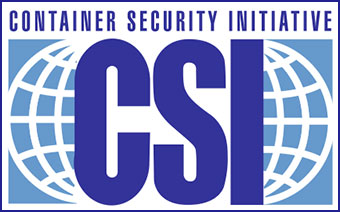
2002
U.S. Customs establishes the CONTAINER SECURITY INITIATIVE (CSI). Core elements establish criteria for: identifying high-risk containers; pre-screening of containers before they are shipped to the United States; the use of technology to pre-screen high risk containers; development and use of smart and secure containers.
August 6, 2002
The Trade Adjustment Assistance Reform Act of 2002 (the Trade Act) requires advance electronic transmission of information on inbound cargo.
November 25, 2002
President George W. Bush signs bill creating the DEPARTMENT OF HOMELAND SECURITY.
December 2002
The first phase of Free and Secure Trade (FAST) is deployed to coordinate U.S. and Canadian commercial customs programs.

2003
DHS temporarily transitions Air and Marine Interdiction Division to Immigration and Customs Enforcement.
Congress mandates the creation of a Northern Border Air Wing.
Border Safety Initiative is announced. Its aim is to prevent desert deaths of people trying to cross the borders illegally.
24-HOUR RULE is established. Under this requirement, manifest information must be provided 24 hours prior to the sea container being loaded onto the vessel in the foreign port.
Customs Trade Partnership Against Terrorism (C-TPAT) is launched, creating a public-private and international partnership including most of the largest U.S. importers to prevent legitimate commercial shipments from being used for illegal purposes.

March 1, 2003
U.S. CUSTOMS AND BORDER PROTECTION (CBP) is created as part of the Department of Homeland Security. The U.S. Customs Service is transferred to CBP, along with the U.S. Border Patrol, the U.S. Department of Agriculture, Animal and Plant Health Inspection Service, and inspection function of the U.S. Immigration and Naturalization Service.
May 2003
The Department of Homeland Security (DHS) United States Visitor and Immigrant Status Indicator Technology (US-VISIT) Program is established to implement several statutes designed to enhance immigration controls, the integrity of our national borders, and, ultimately, our national security. These statutes collectively require DHS to create an automated entry and exit system; use available data to match alien arrival and departure records; use biometrics to deprive criminals and potential terrorists the ability to cross U.S. borders using fraudulent documents; and screen visa applicants and applicants for admission into the United States against law enforcement databases.
June 12, 2003
The Public Health Security and Bioterrorism Preparedness and Response Act is enacted requiring prior notification to CBP and the U.S. Food and Drug Administration (FDA) of food imports.
July 2003
Northern Border Security is enhanced by deploying more than 375 additional Border Patrol agents to the northern border.
October 17, 2003
CBP officially adopts the AUTOMATED COMMERCIAL ENVIRONMENT (ACE) Secure Data Portal to provide easy-to-use access to consolidated border processing information and to increase import and export efficiency while enhancing border security.
The ACE Secure Data Portal is launched with 41 importer accounts and CBP personnel supporting those accounts, sharing information online.
2004
CBP unveils new highly sophisticated radiation portal monitors that scan cargo shipments in Jersey City, N.J. to better prevent the smuggling of radiological materials used in nuclear and radiological dispersal services (for example, "dirty bombs") through U.S. seaports.
DHS moves Air and Marine Operations from Immigration and Customs Enforcement to CBP.
The first and second air branches of the northern border become operational in Bellingham, Washington and Plattsburg, New York.
CBP Partners with the Food and Drug Administration to establish the 24/7 Prior Notice Center to assess the risks of imported food shipments.
March 2004
Supreme Court upholds CBP authority to disassemble and thereby search a vehicle's gas tank for terrorist weapons, drugs, and other contraband, without the need to obtain a warrant or probable cause.
U.S. Customs and Border Protection Valor Memorial is unveiled at Washington, D.C. headquarters. The Memorial honors those agents, officers, and employees who have lost their lives in the line of duty.
June 2004
The first sustained civilian use of unmanned aerials to curb illegal activities is put in place along Arizona's southern border.

December 2004
World Customs Organization endorses a Framework of Standards to secure and facilitate global trade based upon principles designed and implemented by CBP.
U.S. Visitor and Immigrant Status Indicator Technology (US -VISIT) program is instituted in 50 busiest land border ports of entry. It provides visa-issuing posts and ports of entry with biometric technology that allows a traveler's identity to be established and verified.

2005
CBP creates the AG/BIO-TERROR COUNTERMEASURES (ABTC) program with the mission to prevent the entry of ag/bio-terrorists and their weapons and equipment.
CBP begins operations of its first PREDATOR B unmanned aircraft system.
April 4, 2005
Customs and Border Protection (CBP) Commissioner Robert C. Bonner announced that the organizational component responsible for promoting the integrity and security of the CBP workforce would be renamed the Office of Management Inspections and Integrity Assurance (MIIA). The new office replaced the office formerly known as Internal Affairs. Mr. Arthur Sinai was named Acting Assistant Commissioner for MIIA and served from April 2005 through March 2006.
August 2005
The WESTERN HEMISPHERE TRAVEL INITIATIVE is announced which requires all U.S. citizens, Canadians, citizens of the British Overseas Territory of Bermuda, and citizens of Mexico to have a passport or other accepted secure document to enter or re-enter the United States.
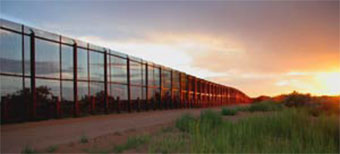
November 2005
SECURE BORDER INITIATIVE with increased staffing, new technology, enhanced infrastructure investment and regulations.
January 17, 2006
CBP announces the establishment of the Office of Air and Marine. CBP also announces the integration of marine assets.
May 2006
Operation Jump Start allows National Guard troops to be deployed to the southern border to assist the Border Patrol.
June 5, 2006
W. Ralph Basham becomes the second commissioner of U.S. Customs and Border Protection.
July 9, 2006
CBP Commissioner W. Ralph Basham announced the office would reclaim the official title Office of Internal Affairs.
October 15, 2006
The Office of International Trade (OT) is established to consolidate trade policy, program development, and compliance measurement functions into one CBP office.
October 13, 2006
The SAFE Port Act to strengthen port and supply chain security becomes law. Among its provisions is a requirement to use radiation detection devices at U.S. ports.

2007
Operation Against Smugglers Initiative for Safety and Security is expanded by both the United States and Mexico as a successful cross-border prosecution and deterrent to smugglers who jeopardize the lives of aliens.
CBP launched the National Agriculture Release Program (NARP), an automated program that allows the inspection of high-volume, very-low risk commodities to be expedited. NARP will allow CBP to divert valuable resources to other high risk agricultural commodities which facilitates trade and enhances customer service.
CBP deployed the AUTOMATED COMMERCIAL ENVIRONMENT (ACE) electronic truck manifest (e-Manifest) system to 98 of 99 land border ports and are processing nearly 30,000 trucks a day.
e-Allegations, an online trade violation reporting system, provides concerned members of the public a means to confidentially report suspected trade violations.
March 2007
First SBInet integrated mobile sensor tower tests successfully in Fort Walton Beach, Fla.
April 2007
"Model Port" prototype designed to create a more welcoming environment at U.S. international airports is implemented at George Bush Intercontinental Airport in Houston.
April 11, 2007
Phase I of the SECURE FREIGHT INITIATIVE (SFI), designed to prevent nuclear terrorism, is piloted at two of the first six foreign ports. SFI program scans containers for radiological material before they are allowed to depart for the United States. Private sector partners include a global coalition of terminal operators, ocean carriers, and shippers.
September 30, 2007
CBP completes 154.7 miles of primary fence along the southwest border.
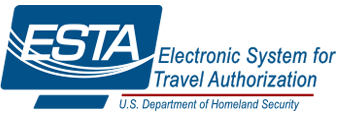
2008
GLOBAL ENTRY, a customer service and security program designed to expedite the screening and processing of pre-approved, low-risk U.S. citizens and lawful permanent residents traveling from abroad to the United States, was launched.
The ELECTRONIC SYSTEM FOR TRAVEL AUTHORIZATION (ESTA) is launched. ESTA is a new online system that is part of the Visa Waiver Program (VWP). ESTA requires all nationals or citizens of visa waiver countries who plan to travel to the United States for temporary business or pleasure under the VWP to receive an electronic travel authorization prior to boarding a U.S.-bound airplane or cruise ship.
January 2008
Under the Western Hemisphere Travel Initiative (WHTI), verbal declaration of citizenship is no longer accepted by CBP officers and agents. All adult travelers are required to present proof of citizenship, such as a birth certificate, and proof of identity, such as a driver's license, when entering the United States through land and sea ports of entry.
October 29, 2008
CBP announces a partnership with the Consumer Product Safety Commission (CPSC) and importers to expand the ISA program with a two year Product Safety Pilot (ISA-PS). It is a voluntary approach to product safety compliance, working to prevent unsafe imports.
2009
CBP officially opens the Unmanned Aircraft System Operations Center in North Dakota.
January 26, 2009
The Importer Security Filing Program, known as "10+2" goes into effect. It is designed to identify high-risk shipments to prevent smuggling and ensure the safety and security of cargo arriving by vessel.
January 21, 2009
Janet Napolitano becomes the third United States Secretary of Homeland Security. She is the first woman to serve in this position.
March 2, 2009
Acting Commissioner Jayson Ahern and Jennifer Porter, chairperson of the Kootenai Tribe of Idaho, sign an agreement that establishes and Enhanced Tribal Card as a means to document a tribe member's identity, tribal membership and citizenship. The agreement is a major milestone in the implementation of Western Hemisphere Travel Initiative.

June 1, 2009
Travelers entering the United States by land and sea, who were previously exempt, including citizens of the United States, Canada and Bermuda are now required to have travel documentation under the Western Hemisphere Travel Initiative.
November 28, 2009
CBP assumes control of immigration procedures for the Commonwealth of the Northern Mariana Islands (CMNI). CBP's role in this historic undertaking began on January 16, 2009, when it published an interim final rule on the Guam-CNMI Visa Waiver Program. The new program extends the period of admission from 15 days to 45 days, expands the geographic area from Guam only to Guam and the CNMI, and modifies the list of eligible countries.

March 2010
CBP officially designates Shannon International Airport (EINN) as the first authorized preclearance location for General Aviation (GA) aircraft passengers transporting up to 19 passengers and crewmembers.
July 9, 2010
Commissioner Bersin announced the establishment of the Office of Technology Innovation and Acquisition (OTIA). Two existing elements were transferred into the new organization; the Office of Secure Border Initiative (SBI and SBInet), and elements of the Acquisition Program Management Office within the Office of Administration. A new position, Assistant Commissioner, Office of Technology Innovation and Acquisition, was also established.
January 28, 2011
New regulations are published in the Federal Register. A final rule amendment allows additional U.S. airports to request approval from CBP to process authorized flights between the U.S. and Cuba. Properly authorized flights to and from Cuba are now able to arrive at or depart from any U.S. airport that CBP has approved. The initial authorized list of airports includes John F. Kennedy International Airport, Los Angeles International Airport, and Miami International Airport. The ruling marks another step in drawing the two nations, which have not had formal diplomatic ties since 1961, closer to a more cordial relationship.

May 20, 2011
Grand Opening of CBP's GLOBAL BORDERS COLLEGE (GBC) located on the campus of the CBP Advanced Training Center in Harpers Ferry, WV. The new 60,000 sq.ft. facility houses six classrooms and class break-out rooms, a computer lab, several conference rooms and over 80 staff offices.
Photo from Perpectus ArchitectureCBP's Global Borders College (GBC)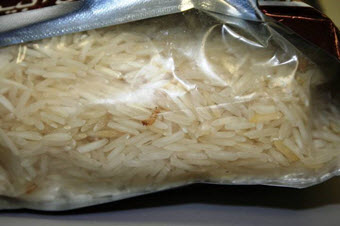
July 30, 2011
Since 9/11, CBP has trained more agriculture specialists, implemented more stringent targeting techniques, improved partnerships with Animal and Plant Health Inspection Service (APHIS) and enhanced communications with the state agriculture departments. An example of strengthened partnerships and enhancements in training and technology is CBP’s interception of the khapra beetle. Due to an increasing number of khapra beetle detections at U.S. ports of entry in shipments of rice, the U.S. Department of Agriculture issued a federal quarantine that restricts the importation of rice from khapra beetle endemic countries effective July 30.
Khapra Beetle larvae was found at Los Angeles International Airport in a container of rice included in personal effects being imported in 2011.
August 8, 2011
Deputy Commissioner David Aguilar attends the New Orleans Custom House Rededication Ceremony and return of employees forced to relocate following Hurricane Katrina. Invited guests include Secretary Janet Napolitano; General Services Administration Regional Administrator, J.D. Salinas, III; Senator Mary Landrieu; Congressman Cedric Richmond; Suresh Kumar, Assistant Secretary for Trade Promotion and Director General of the U.S. and Foreign Commercial Service (USFCS); and Director, US Export Assistance Center (USEAC) Louisiana Office, Donald van de Werken.
A large crowd took part in the ceremony, held in the massive marble hall.
September 28, 2011
CBP Agriculture Specialists Thomas Schauweker and Jacob McDowell discover a tree frog sitting among a pallet of imported Syrian stone. They captured the frog and delivered it to U.S. Fish and Wildlife specialists, who tentatively identified the specimen as a Middle Eastern Tree Frog. A herpetologist at the Houston, TX zoo identified the frog as a Sevigny’s Tree Frog. The zoo accepted the frog and is now the only U.S. zoo with this species of tree frog in residence.
December 2011
CBP officers arrest LAPD Most Wanted Fugitive as he arrived from Korea at LAX. The suspect, accused of murdering two males during a gang affiliated altercation, has been wanted for the past 12 years. He is accused of attempted murder for shooting two males during a gang affiliated altercation. In fiscal year 2011 CBP officers arrested 8,195 people wanted for crimes, including murder, rape, assault, and robbery. CBP officers also denied entry to more than 215,600 people attempting to enter the U.S. through an air, land or sea port of entry who were found inadmissible for immigration, customs, health, criminal or national security reasons.
May 7, 2013
Launch of Automated Passport Control (APC), an innovative technological solution and collaborative approach to improving travel efficiency developed by the Vancouver, B.C. Airport Authority. This is a first-of-its-kind partnership between CBP and the Vancouver, B.C. Airport Authority that enables eligible passengers traveling from Vancouver, B.C. International Airport to the U.S. to clear customs more efficiently by entering passport information at a self-service BorderXpress kiosk.

June 6, 2013
Opening of the Global Entry Enrollment Center in the Ronald Reagan Federal Building. As of June 6, 2013, Global Entry is a permanent program with locations at 44 international airports, serving 98 percent of incoming travelers to the U.S. DHS Secretary Janet Napolitano cut the ribbon, opening the center.
DHS Secretary Janet Napolitano cuts the ribbon opening the Global Entry Enrollment Center.2014
- Pure finished fentanyl powder from China first seen in 2014.
- Overdose Deaths: No Data | CBP Seizures: 7lbs

March 2014
Agriculture specialists at the Pharr-Reynosa International Bridge intercepted a rare, first-in-the-nation discovery in an incoming shipment of celery: the Amnestus brunneus (Signoret), which is not known to exist in the U.S. Amnestus brunneus belongs to the Cydnidae family, commonly known as burrowing bugs, which feed on roots of plants.
June 2014
Revelation of an urgent humanitarian crisis resulting from a steep increase in unaccompanied children (UAC's) arriving at the Texas border. 90,000 women and children entered the U.S. in the first six months of 2014 - mainly from El Salvator, Honduras and Guatemala. DHS Secretary Jeh Johnson declared a level-four condition of readiness within the department, which claims the situation has exceeded the capacity of CBP and ICE, and additional resources are necessary from DHS and other departments and agencies. The message from the Administration is clear: Those crossing illegally into the U.S. will not be eligible to earn a path to citizenship. Illegal immigrants will also not be eligible for citizenship under the comprehensive immigration legislation under consideration, nor would they be eligible for deferred action for childhood arrivals.
2015
- Overdose Deaths: 92,791 | CBP Seizures: 70lbs
April 2015
The Laredo World Trade International Bridge is ranked as the No. 1 busiest land border crossing for commercial trucks in the nation. The World Trade Bridge opened on April 15, 2000. There are 4 international bridges in Laredo (all owned by the City of Laredo): The Gateway to the Americas Bridge, opened 1956; The Lincoln-Juarez International Bridge, opened in 1976; The Columbia-Solidarity International Bridge, opened 1992; and The World Trade International Bridge, opened in 2000.
August 7, 2015
CBP launches “Know the Facts,” a new ad campaign warning potential migrants from El Salvador, Honduras, Guatemala, and Mexico against illegal immigration. The public information campaign placed Spanish-language radio spots in Mexico, along with strategically place posters, television, and radio spots in El Salvador, Guatemala, and Honduras. The purpose of the campaign is to increase awareness of U.S. immigration policies, enhanced border enforcement, and the dangers of the journey to the United States. The campaign emphasizes that current immigration policies do not provide new relief to people who cross the border illegally and that they will be a priority for removal.
2016
Increased CBP Response
- Workforce Protection (PPE, Naloxone)
- Lab FOL expansion/capabilities
- Gemini analysis
- Overdose Deaths: 170,776 | CBP Seizures: 669lbs
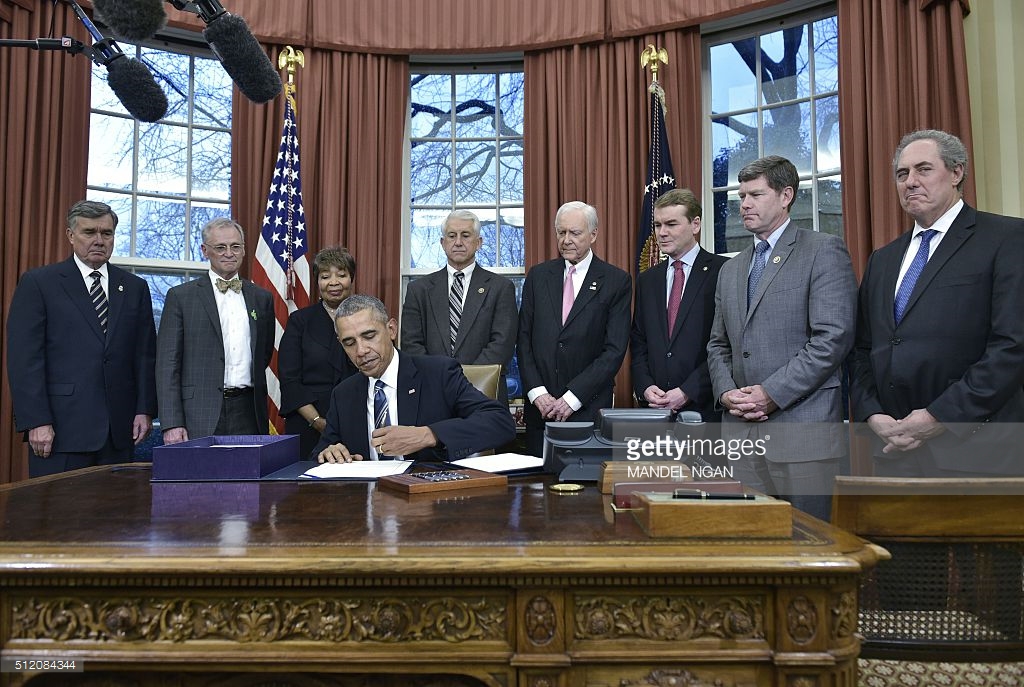
February 24, 2016
On Wednesday, February 24, 2016, President Obama signed the Trade Facilitation and Trade Enforcement Act of 2015. Also known as the Customs Reauthorization Bill, this was the first reauthorization for CBP since its creation within DHS in 2003. It supports efforts to ensure a fair and competitive trade environment with effective enforcement of U.S. trade laws in key areas, including intellectual property rights and anti-dumping countervailing duty laws, among others.
Mandel NGan, Getty ImagesPresident Obama signs the Trade Facilitation and Trade Enforcement Act of 2015Enterprise Services Officially Operational
On June 15, 2016, Enterprise Services is officially operational as a result of the 2016 CBP Headquarters Realignment. Under the Executive Assistant Commissioner for Enterprise Services, eight mission support offices are grouped together under one organizational umbrella, including: Office of Accountability, Office of Finance, Office of Human Resources Management, Office of Training and Development, Office of Facilities and Asset Management, Office of Information and Technology, Office of Acquisition, and Office of Programming.
2017
- Overdose Deaths: 302,727 | CBP Seizures: 2,107lbs
2018
Synthetic Opiiod Strategy Released
- Investments due to Interdict act
- Funding, Mail Data (AED)
- 24/7 Narcotics Reachback Center for Gemini support developed within the NTC-LSS
- Overdose Deaths: 362,713 | CBP Seizures: 2,193lbs
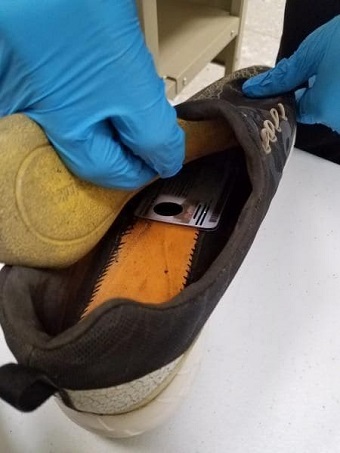
August 22, 2018
CBP's airport facial recognition system caught its first imposter at Dulles International Airport. A Congolese man posing as a French citizen allegedly attempted to enter the U.S. using someone else's passport. When his facial recognition image did not match his passport photo, a CBP officer conducted a secondary inspection and found the real Congolese identity card hidden in the man's shoe.
CBP PhotoAfter the facial recognition system caught a discrepancy, CBP officers found the imposter's identity card hidden in his shoe.2019
- China takes actions against criminal actors resulting in significantly decreased flow.
- Mexico took over market to meet / increase demand for fentanyl, focusing on less potnet finished pills / powder cut with adulerants.
- Precursors and pill press / parts from China flow to the U.S.
- Overdose Deaths: 480,205 | CBP Seizures: 2,804lbs

February 2019
U.S. Customs and Border Protection employees at Toronto Preclearance operations welcomed CBP K-9 "Wade" to the team in February 2019. Wade is the first CBP agriculture canine to be posted at preclearance operations at the Toronto Pearson International Airport.
CBP PhotoCBP Beagle Wade is the first beagle to work at CBP Toronto Preclearance.
March 2019
CBP begins comprehensive critical response to the COVID pandemic, ensuring safe importation of personal protective equipment, medical supplies, and medicines.
CBP Photo2020
COVID:
- Caused decrease in seizures in beginning of year – by summer, opioid seizures return to pre-COVID levels, with evidence that TCOs are changing TTP.
- Overdose Deaths: 574,370 | CBP Seizures: 4,791lbs
USMCA
The United States-Mexico-Canada Agreement went into effect, replacing the North American Free Trade Agreement, to mutually benefit North American workers, farmers, ranchers, and businesses. This agreement leveled the playing field for American workers with improved rules of origin, better protection of intellectual property, and benefits for small-and medium-sized businesses. OT played a key role in the implementation of the USMCA by writing and developing legal and regulatory documents, including the regulations for the agreement, establishing the USMCA Center to provide resources to internal and external stakeholders and ensuring compliance with USMCA requirements. These efforts have led to the facilitation of $1.45 trillion USMCA imports since the implementation of the agreement through December 31, 2022.
First Class of Border Patrol Processing Coordinators Graduates
In January 2021, the Office of Training and Development graduates the first class of Border Patrol Processing Coordinators (BPPCs), marking the first new frontline position created since CBP’s inception in 2003. BPPC’s were established with bi-partisan support to assist with administrative, processing, and humanitarian duties for people in the care and custody of the U.S. Border Patrol, allowing agents to return to their primary frontline homeland security mission.
2021 through 2022
- CBP leverages international and domestic partnerships to combat fentanyl precursor chemicals
- Overdose Deaths 2021: 778,588 | CBP Seizures 2021: 11,201lbs
- Overdose Deaths 2022: 873,721 | CBP Seizures 2022: 14,700lbs
Line of Duty Deaths Policy Change
In January 2021, the Office of Human Resources Management facilitated a policy change and obtained buy-in from operational offices to recognize all line of duty deaths equally. HRM created a directive that assures all employees who die in the line of duty, including those who are non-law enforcement, are memorialized on the CBP Valor Memorial.
2023
NSC SIP FEB
- Whole-of-government strategy, 4 pillars (CBP lead on supporting many) precursors pill press/parts, movement, illicit finance.
- Overdose Deaths: 911,533 | CBP Seizures: 27,023lbs
Operation Four Horseman | March 6, 2023 - May 6, 2023
Focused on USBP, routes of egress away from the border region.
March 13,2023 - May 7, 2023
Targeted inspections at border crossings in CA and AZ.
Rolling Wave | May 26, 2023 – September 17, 2023
USBP and OFO supplemented Artemis with network buildout.

